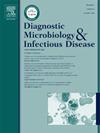Bloodstream infections by multidrug-resistant Pluralibacter gergoviae in premature neonates in Central-West Brazil: Report of two cases
IF 2.1
4区 医学
Q3 INFECTIOUS DISEASES
Diagnostic microbiology and infectious disease
Pub Date : 2025-03-11
DOI:10.1016/j.diagmicrobio.2025.116798
引用次数: 0
Abstract
Two cases of bloodstream infections caused by multidrug-resistant Pluralibacter gergoviae (KPC+) in premature neonates hospitalized in a neonatal intensive care unit in Brazil are presented. Strains from these cases were confirmed by 16S rRNA sequencing and matrix assisted laser desorption ionization-time of flight/mass spectrometry using MALDI Biotyper®, with further typing using Fourier-transform infrared spectroscopy using IR Biotyper®. The cases were unrelated, as evidenced by clustering analysis. Both neonates displayed risk factors including prolonged hospitalization, invasive device use, and prior antibiotic treatments. Case 1 exhibited clinical recovery following treatment with polymyxin B and amikacin, whereas Case 2 resulted in death despite multiple antibiotic regimens. Isolated strains showed resistance to carbapenems and harbored the blaKPC, highlighting the critical need for targeted diagnostics and stringent infection control in neonatal intensive care units. These findings underscore the significance of monitoring emerging pathogens like P. gergoviae, which possess high multidrug resistance and limited therapeutic options.

巴西中西部早产儿耐多药gergoviae多利杆菌血流感染:两例报告
本文介绍了巴西一家新生儿重症监护室收治的两例早产新生儿因耐多药革兰氏菌(KPC+)引起的血流感染病例。这些病例中的菌株通过 16S rRNA 测序和使用 MALDI Biotyper® 进行基质辅助激光解吸电离飞行时间/质谱分析得到确认,并使用 IR Biotyper® 进行傅立叶变换红外光谱分析进一步分型。聚类分析显示,这两个病例没有关联。两个新生儿都有风险因素,包括长期住院、使用侵入性设备和曾接受抗生素治疗。病例 1 在使用多粘菌素 B 和阿米卡星治疗后临床痊愈,而病例 2 在使用多种抗生素治疗后仍死亡。分离出的菌株显示出对碳青霉烯类抗生素的耐药性,并携带 blaKPC,这凸显了在新生儿重症监护病房进行针对性诊断和严格感染控制的迫切需要。这些发现强调了监测像麦角菌这样的新病原体的重要性,因为麦角菌具有高度的多重耐药性,而且治疗方案有限。
本文章由计算机程序翻译,如有差异,请以英文原文为准。
求助全文
约1分钟内获得全文
求助全文
来源期刊
CiteScore
5.30
自引率
3.40%
发文量
149
审稿时长
56 days
期刊介绍:
Diagnostic Microbiology and Infectious Disease keeps you informed of the latest developments in clinical microbiology and the diagnosis and treatment of infectious diseases. Packed with rigorously peer-reviewed articles and studies in bacteriology, immunology, immunoserology, infectious diseases, mycology, parasitology, and virology, the journal examines new procedures, unusual cases, controversial issues, and important new literature. Diagnostic Microbiology and Infectious Disease distinguished independent editorial board, consisting of experts from many medical specialties, ensures you extensive and authoritative coverage.

 求助内容:
求助内容: 应助结果提醒方式:
应助结果提醒方式:


